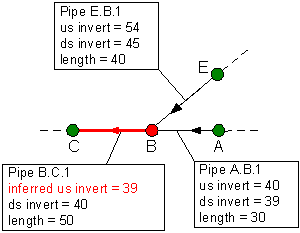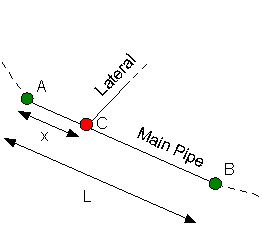Missing data values can be inferred from existing data, allowing gaps in data to be filled in with reasonable values.
Inference data is edited on the Inference Data Editor.
The following can be inferred for pipes:
|
Parameter |
Inferred From |
||||||||||||||||||||||||||||||||||||||
|---|---|---|---|---|---|---|---|---|---|---|---|---|---|---|---|---|---|---|---|---|---|---|---|---|---|---|---|---|---|---|---|---|---|---|---|---|---|---|---|
|
Upstream / Downstream Invert Level |
There are five methods by which invert level can be inferred: Invert from Cover LevelPipe US Invert Level and DS Invert Level values are inferred from connected node Cover Level values:
If either the node Cover Level or pipe Depth from Cover are not defined, inference will not be carried out. Invert from Lowest SoffitPipe US Invert Level and DS Invert Level values are inferred from the lowest soffit level of pipes connected to the node at which the pipe invert level is missing.
See the Invert from Lowest Soffit section below for further details. Invert from GradientsPipe US Invert Level and DS Invert Level values, for a pipe with one missing invert level, are inferred from the pipe's known invert level and the shallowest gradient of connecting pipes.
Where ΔH = Shallowest gradient of connected pipes multiplied by length of pipe to be inferred. See the Invert from Gradients section below for further details. Invert from Lateral ConnectionThe invert level at a lateral connection is inferred from invert levels of the pipe to which it is attached, and the ratio of the distances of the lateral connection from the upstream and downstream nodes of the main pipe. See the Invert from Lateral Connection section below for an example. Invert Interpolate from InvertsThe invert level of a pipe is inferred by linear interpolation between known upstream and downstream inverts. See the Interpolate from Inverts section below for an example. |
||||||||||||||||||||||||||||||||||||||
|
Length |
Pipe Length is inferred from pipe geometry (coordinates of connected nodes and bend locations).
|
||||||||||||||||||||||||||||||||||||||
|
Gradient |
Gradient is calculated as:
Pipes must have an US Invert Level, DS Invert Level and Length> 0 for inference to be carried out. |
||||||||||||||||||||||||||||||||||||||
|
System Type |
Pipe System Type is inferred from connected node System Type values. Pipe System Type = US node System Type = DS node System Type The System Type of upstream and downstream nodes must be identical for a value to be inferred. |
||||||||||||||||||||||||||||||||||||||
|
Size and Shape |
Height, Width and Shape can be inferred from upstream and downstream pipes. Shape will only be inferred if the Infer Shape parameter is checked in the Inference Editor. If an upstream or downstream size or shape value of a pipe is missing, the missing value is inferred from:
|
||||||||||||||||||||||||||||||||||||||
|
Start and End Nodes |
Use the Add manhole if node does not exist rule, to add nodes to the nodeless ends of pipes. A node of type manhole will be created at the end of pipes with an US Node ID or DS Node ID (that is not a reserved node name) where the node does not exist in the network. |
Invert from Lowest Soffit
Missing Pipe Invert Level values are inferred from the lowest soffit level of incoming pipes connected to the node at which the pipe invert level is missing.
When inferring invert values for a selection, select the Node attached to the pipe for which the value is to be inferred.
For each (selected) node in the network:
- The soffit level of Incoming Pipes with a known
Height and Invert level is calculated:
- Soffit Level = DS Invert Level + DS Height
- The lowest Soffit Level of all incoming pipes is determined from Step 1.
- For pipes connected to the node with a missing
invert level and known Height, the invert
level is calculated as:
- Incoming Pipes:
- Outgoing Pipes:
DS Invert Level = Lowest Soffit of incoming pipes - Pipe DS Height
US Invert Level = Lowest Soffit of incoming pipes - Pipe US Height
Invert from Gradients
Pipe US Invert Level and DS Invert Level values, for a pipe with one missing invert level, are inferred from the pipe's known invert level and the shallowest gradient of connecting pipes.
For a pipe with either the US Invert Levelor the DS Invert Level missing, and a valid Height and Length(i.e. greater than zero):
- A search is made for pipes connected to the other side of the node at which the pipe invert level is missing.
- The gradients for connected pipes found in Step
1 are calculated from:

For gradients to be calculated, pipes must have:
- Known US Invert Leveland DS Invert Level
- Length > 0
- Length < Maximum Pipe Length (specified in Inference Editor)
- The shallowest gradient calculated in Step 2 is
determined:
For a gradient to be used in inference the following criteria must be satisfied:
- Gradient > 0
- Gradient < Maximum Pipe Gradient (specified in Inference Editor)
- The difference between US and DS invert levels of the pipe with the missing invert level is calculated as:
- Missing invert levels are calculated as:
- US Invert Level = DS Invert Level + ΔH (Step 4)
- DS Invert Level = US Invert Level - ΔH (Step 4)
- The soffit level of the pipe at the inferred invert
is calculated:
- Inferred invert + US/DS Height
If the calculated soffit level is greater than the Ground Level at the pipe's connecting node, inference will not be carried out.
- If no gradient has been found then attempt to find a gradient at the conduit's non-missing invert level end by repeating steps 2 to 6.
ΔH = Shallowest gradient determined in Step 3 x Pipe Length
Invert from Lateral Connection
The invert level at a lateral connection is inferred from invert levels of the pipe to which it is attached, and the ratio of the distances of the lateral connection from the upstream and downstream nodes of the main pipe.
Inference will not be carried out if:
- Main Pipe Length<= 0
- Lateral distance from upstream node > Main Pipe Length
- Lateral distance from upstream node < 0
Click on the image below to reveal the Invert from Lateral Connection example.
Example
|
|
Invert from Lateral Connection Example
The ratio, R, of the lateral distance along the length of the pipe is calculated as: R =x / L
The invert level at node C is calculated as: (R x DS Invert Level of AB) + [(1-R) x US Invert of AB)] |
Invert Interpolate from Inverts
The invert level at a pipe is inferred from the invert levels of connected upstream and downstream pipes:
- If there are connected pipes with known invert levels at the location of the invert to be inferred, the unknown invert level is inferred directly from a connected pipe invert.
- If the invert levels of connected pipes at the location of the invert to be inferred are unknown, the unknown invert level is inferred by linear interpolation between known upstream and downstream inverts.
Direct Inference from Connected Pipe Invert
If there is a single connected pipe with known invert level at the location of the invert to be inferred, the invert level at the connected end of the pipe will be used.
If there are multiple connected pipes with known invert levels at the location of the invert to be inferred; the invert level at the connected end of the shortest pipe is used.
Click on the image below to reveal the related example.
Example

Inference by Linear Interpolation
The invert level of a pipe is inferred by linear interpolation between known upstream and downstream inverts:
- Step 1: For each pipe
with missing invert levels, the system searches upstream and downstream
for the closest known upstream and downstream invert levels (including
invert levels of the pipe for which values are being inferred).
- If there are multiple known invert levels at the same distance, the lowest value is taken.
- If there is a current selection of pipes, invert levels of selected pipes will be used in preference to invert levels of non-selected pipes.
- Step 2: Missing invert levels are calculated using linear interpolation between the known upstream and downstream invert levels found in Step 1.
Click on the image below to reveal the related example.
Example

- A run of pipes A-D has unknown invert levels at B and C.
- Pipe AB is selected for inference
- The Interpolate from Inverts rule searches upstream
and downstream to find the known inverts:
- US Invert Level of pipe AB
- DS Invert level of pipe CD
- The DS Invert Level of pipe AB is calculated as:
|
|
where: D = DS Invert Level of pipe CD A = US Invert Level of pipe AB x = Distance from downstream node of Pipe AB to node D L = Total Length from node A to node D |

